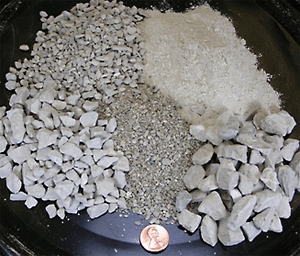Grading of Aggregates
Grading of Aggregates is one which is made up of stones of different sizes, ranging from large to small (inclusive of sand) so as to have minimum of air voids (and that will have maximum density) when mixed together. In grading of aggregates, the voids in the mixed aggregate would be minimum when the sand is just sufficient to fill the voids in the coarse aggregate. Voids in the coarse aggregate are filled in by sand and voids in the sand are filled in by cement. Mix that occupies the least volume is the densest and will produce the best results. The volume of the coarse aggregate is generally taken as twice that of the fine aggregate, but variations of its proportions may be made within the limits of 1.5 to 3 times the volume of the fine aggregate to Suit the size and grading to secure dense and workable concrete. Grading is of great importance since it affects workability of concrete and hence density and strength.
The proportion of voids to volume of well graded sand is 30 to 35 per cent and that of coarse aggregate between 30 and 45 per cent. This should represent the amount of cement required to fill the interstices in the sand and the amount of sand required to fill the interstices in the coarse aggregate. But it has been realized that when sand is added to coarse aggregate the particles of latter are separated by grains of sand so increasing the original volume of voids. To allow for this and to obtain workability, ten per cent extra sand and fifteen per cent extra cement to the percentage of voids in aggregate and sand are usually provided to arrive at the proportions of different materials for a particular mix.
In grading of aggregates, well graded sand from coarse to fine has less voids than fine sand. The lesser the voids the better is the quality of sand for use in cement concrete, provided there is no silt in sand.
The combined aggregate when mixed with the required quantity of cement and water, should give a good workable concrete which can be readily placed in position without segregation. The proportion of fine to coarse aggregate should be such as will give maximum workability with minimum of water. Mixtures with a deficiency of fine materials will be harsh, hard to work and difficult to finish. A little more sand makes the concrete more fluid without extra water. Too much of sand will increase porosity of the concrete and need more cement. Mixes having a larger coarse aggregate require less water and less cement.
For concrete works to be water-roof, a dense mix should be aimed at with small size of aggregate. As little of cement as possible consistent with the required strength of the resulting concrete has to be used for purposes of economy.
While a drying water evaporates and leaves air voids, cement expands in the process and occupies some of the air voids.
Excess of fine materials need more cement and more water. A small amount of very fine material (silt and clay) passing 75-micron (No. 200 BS) sieve may improve the workability of the concrete, but an excess causes reduction in strength. The material passing through 150-micron (No. 100 BS) sieve must not exceed 10 per cent. Crusher dust in broken stone is injurious when present more than 10 per cent. Clay particles although less injurious, but should not be more than 5 per cent.
Nominal mix is the proportion of cement, sand and broken stone; all the three measured separately by volume (dry materials).
Real mix is the proportion of cement to a mixture of sand and stones by volume. Sand and stones when mixed together will occupy less volume than when measured separately.
Field mix. The proportion of wet sand and stones taken to make particular nominal mix is called a “field mix.”

